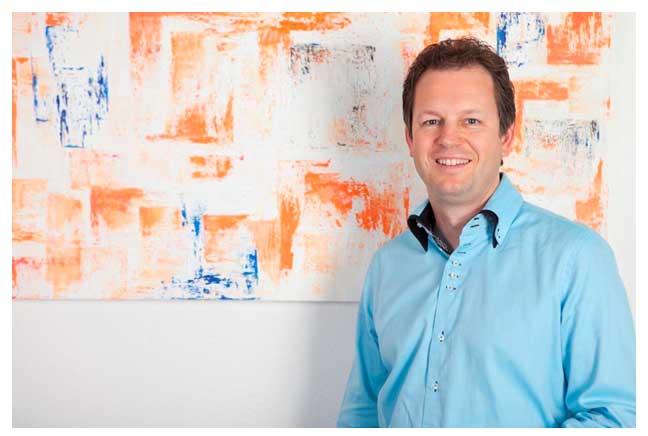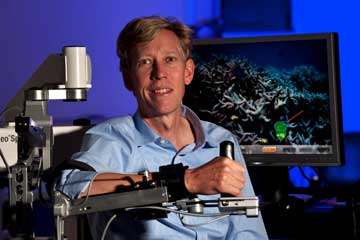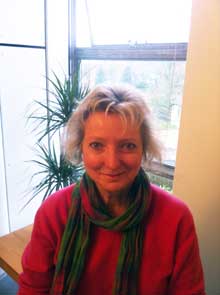
ICORR 2013 Workshop
Where Rehabilitation Robotics Industry comes from and where it should go?
Organizer:
Gery Colombo, PhD
PhD Technical Sciences
CEO of Hocoma AG, Switzerland
Workshop Description
Two hour workshop. In the workshop it will be discussed, how technological developments have to be implemented (commercially and clinically) to really make a change in rehabilitation of neurologic patients.
There is a lot of research available today about the principles of motor learning and how these principles can be applied to achieve better outcome in functional movement therapy. During the last 20 years many different technologies have been developed to both enhance effectiveness and also efficiency of therapy by implementing new devices into clinical practice.
At the moment there seem to be many technological developments going on in research and in the industry but only little of the existing approaches find their way into wide clinical use.
In the workshop we would like to discuss where the technologies come from and where the development should go to. The presentations and discussions should show, what aspects of research, development and implementation have to be improved to maximize the benefit of these new technologies for the patients.
While clinical effectiveness normally has a lot of attention, other aspects like usability, price, service, return on investment (efficiency), assessment possibilities and others mostly have too little.
All the advantages of the new technologies will not have much effect on clinical practice if they are not being produced and widely applied in the rehabilitation settings. Therefore technology transfer of the new technologies is as important as the education of clinical personnel and the creation of new technical and clinical standards. The first step of the revolution has been made but still a lot of work has to be done.
Workshop Presentations
| From technology push to patient need. How new technology became a clinical and commercial demand in rehabilitation | David Reinkensmeyer, University of California at Irvine | 30 min |
| The expert opinion on what is needed to become a clinically and commercially accepted product. Consensus of the European COST action about assessment necessities. | Thiery Keller, IISART and Tecnalia | 30 min |
| How can the industry create additional value to all stakeholders: patients, clinicians and the industry itself. | Gery Colombo, IISART and Hocoma | 30 min |
| What clinicians need to optimize value of robotic devices for clinical application. | Jane Burridge, University of Southampton | 30 min |
Organizer Bios
 Gery Colombo, PhD
Gery Colombo, PhD
PhD Technical Sciences
CEO of Hocoma AG, Switzerland
Gery Colombo received his Dipl. Ing. degree in electrical engineering (M.Sc.E.E.) in 1992 and his Doctorate (Dr. sc. Techn.) in 2001 from the ETH Zurich, Switzerland. Between 1992 to 2002 he was head of the research laboratory of the paraplegic center of the University Hospital Balgrist in Zurich.
During this time he developed the Lokomat that was later tech transferred to the Spin-Off company Hocoma. Since 2002 Dr. Gery Colombo is CEO of Hocoma, the company he founded together with two colleagues and that is active in the field of rehabilitation technologies.
Gery Colombo during his research career contributed to more than 40 peer reviewed journal articles. He holds patents in the field of rehabilitation robotics and is an expert in technology transfer. He is one of the founders and president of the International Industry Society of Advanced Rehabilitation Technologies (IISART) and member of WFNR as well as AAATE. He won several prizes, “Entrepreneur of Year 2004” and the “Red Herring 100 Global” being two of the more renown ones.
 David Reinkensmeyer
David Reinkensmeyer
University of California at Irvine
David Reinkensmeyer is Professor in the Departments of Mechanical and Aerospace Engineering, Anatomy and Neurobiology, and Biomedical Engineering at the University of California at Irvine. He received the B.S. degree in electrical engineering from the Massachusetts Institute of Technology and the M.S. and Ph.D. degrees in electrical engineering from the University of California at Berkeley, in 1988, 1991, and 1993, respectively, studying robotics and the neuroscience of human movement. He carried out postdoctoral studies at the Rehabilitation Institute of Chicago and Northwestern University Medical School from 1994 to 1997, building one of the first robotic devices for rehabilitation therapy after stroke. He became an assistant professor at U.C. Irvine in 1997, establishing a research program that develops robotic and sensor-based systems for movement training and assessment following neurologic injuries and disease. He is a co-inventor of the T-WREX, commercialized as ArmeoSpring by Hocoma. He recently served as the chair of the National Science Foundation initiated International Study on Technology for Mobility, and is the lead researcher for iMove, a collaborative effort at U.C. Irvine focused on using technology to help restore human mobility.
 Jane Burridge
Jane Burridge
University of Southampton
Jane Burridge is a physiotherapist by training and has worked clinically in stroke rehabilitation for many years. She is now Professor of Restorative Neuroscience at the University of Southampton, where she leads the multidisciplinary Rehabilitation Technologies Research group. Her research encompasses non-invasive brain stimulation, robot therapy and Functional Electrical Stimulation and she is particularly interested in the neuroscience of recovery following stroke. Jane is president of the International Functional Electrical Stimulation Society (IFESS). Her research is funded by the UK EPSRC and NIHR, and EU FP7 and by UK medical charities.